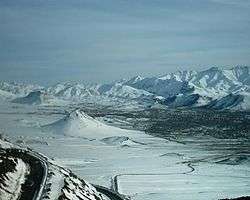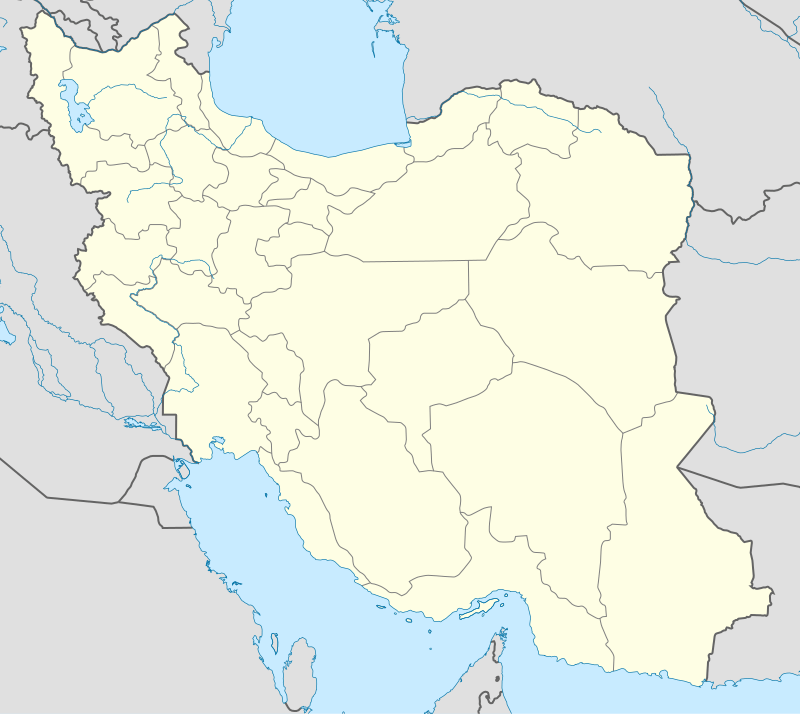Tafresh
Tafresh[2] (Persian: تفرش, Tafreš) is a city and the capital of Tafresh County, in Markazi Province, Iran. As of the 2011 census, its population was 25,912 (including 12,884 men and 13,028 women).[3] The inhabitants are Persian-speaking.
Tafresh تفرش | |
|---|---|
City | |
 Tafresh in winter | |
 Tafresh | |
| Coordinates: 34°41′31″N 50°00′47″E | |
| Country | |
| Province | Markazi |
| County | Tafresh |
| Bakhsh | Central |
| Population (2016 Census) | |
| • Total | 16,493[1] |
| Time zone | UTC+3:30 (IRST) |
| • Summer (DST) | UTC+4:30 (IRDT) |
Tafresh is located amidst high mountains 222 kilometres (138 mi) southwest of Tehran.
The flight distance between Tehran and Tafresh is 170 km towards southwest. The average altitude of Tafresh is 1912 meters above sea level, with a continental and semi-arid climate with an annual rainfall of 270 mm.
Despite its small size Tafresh is known in Iran for being the cradle of science, literature, culture and art, as well as a land of mountains and plains, springs and waterfalls.[4]
History
Tafresh, also called Tabres in historical sources, is believed to be one of the oldest regions in the present Markazi province and constituted a Zoroastrian stronghold in antiquity. A famous general by the name Delaram of Tafresh fought in the defense of Sasanian Iran during the Islamic conquest and has given name to the village Delaram nearby Tafresh. Today the village is also called Teraran.
There are fifty historical monuments in Tafresh that have been listed as part of Iranian national heritage. These include ruins of Zoroastrian places of worship and burial sites (so-called dakhmas) in and around the town, particularly on the summits of the surrounding mountains and hills. There are also remains of Zoroastrian dakhmas in nearby villages, such as in Kaburan and Khalchal.[5]
The father of the Persian poet Nezami Ganjavi, writer of numerous romantic epics, was born in Tafresh.
Learning and culture


Tafresh has provided Iran with many notable figures such as poets, ministers, statesmen, scientists and calligraphers, especially from Qajar times and onwards. The Qajar statesmen Amir Kabir and Ghasem Magham Farahani hailed from the Tafresh Province. The strong tradition of learning reassured the early establishment of modern schools in the early 20th century.
Famous scientists from Tafresh include Mahmoud Hessaby, the father of modern physics in Iran,[6] Ahmad Parsa, the father of Iranian botanics, Abbas Sahab, the father of cartography in Iran,[7] Mohammad Gharib, the father of pediatrics in Iran, and Abdolkarim Gharib, the father of modern geology in Iran.
For this reason Tafresh has received the nickname "City of Iran's Fathers" (Shahr-e pedarān-e Irān). The city has preserved its position as an important Iranian scientific and literary center in the 21st century due to its modern universities.
The village of Delaram, with a population today of about 250 people, is famous as the "Village of physicians" (Dehkade-ye pezeshkān) since it has produced more than 175 physicians.[8]
Traditional handicrafts
Tafresh is famous for its traditional carpet weaving and artistic metalworking. The Tafresh carpet is of the Hamadan type but the quality is finer than the average production of that area.
Universities
Three universities are situated in Tafresh:
- Tafresh University (formerely branch of Amirkabir University of Technology).
- Islamic Azad University, Tafresh branch.
- Payame Noor University, Tafresh branch.
Notable people
- Ashk Dahlén, professor, scholar in Iranian Studies, translator
- Fereydoun Farrokhzad, originally from Tafresh, singer, actor, TV host, political figure
- Forough Farrokhzad, originally from Tafresh, poet, film director
- Nizami Ganjavi, originally from Tafresh, poet
- Mohammad Gharib, pioneer in pediatrics
- Mahmoud Hessabi, originally from Tafresh, scholar of modern physics
- Ali Mansour, originally from Tafresh, prime minister
- Mehran Modiri, originally from Tafresh, director and actor
- Ali Mosaffa, originally from Tafresh, movie actor
- Ahmad Parsa, originally from Tafresh, botanist
- Abbas Sahab, pioneer in cartography
- Shaykh Tabarsi, a Persian Shia scholar
- Parvaneh Vossough, physician, chiefly known for her work for children with cancer
- Hasan Parsa, Civil engineer known for his works Throughout Iran including building bridges/ factories and Dezfool Dam.
References
- "Population". Statistical Center of Iran. Plan and Budget Organization of Iran. Retrieved 8 January 2019.
- Tafresh can be found at GEOnet Names Server, at this link, by opening the Advanced Search box, entering "-3086584" in the "Unique Feature Id" form, and clicking on "Search Database".
- http://www.sci.org.ir/SitePages/report_90/ostani/ostani_population_report_final_permision.aspx
- "Tafresh: City of Science, Literature and Tourism". Iran Online (in Persian). Retrieved 8 January 2019.
- "Khalchal Castle, only Zoroastrian burial structure in middle Islamic centuries". IRNA. IRNA. Retrieved 7 January 2019.
- "Professor Mahmoud Hessaby". Iran Chamber Society. Iran Chamber Society. Retrieved 7 January 2019.
- Firooznia, Firouz. "SAḤĀB, ʿAbbās". Encyclopaedia Iranica. Encyclopaedia Iranica. Retrieved 7 January 2019.
- "175 physicians and professors in Delaram, a village of 250 inhabitants" (in Persian). Fars News. Fars News. 18 April 2016. Retrieved 7 January 2019.
| Wikivoyage has a travel guide for Tafresh. |
| Wikimedia Commons has media related to Tafresh. |
